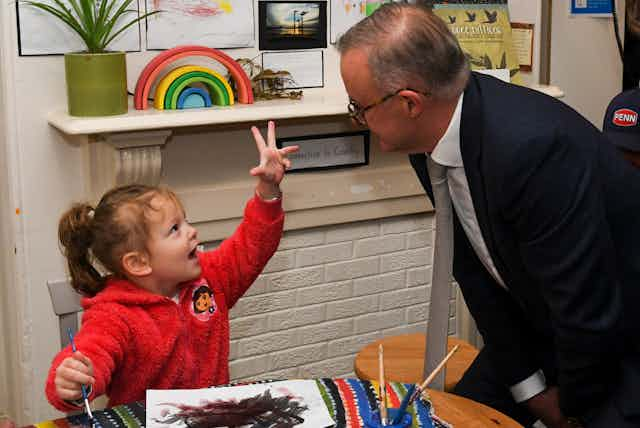Cheaper childcare was Labor’s largest single election promise, at an estimated cost of A$5.4 billion a year. Anthony Albanese went so far as to outline universal childcare as one of his new government’s three main policies for economic reform.
While the cost of childcare for families is a major concern, many other issues confront the sector. Foremost among these is a lack of childcare places in many parts of Australia and low pay for childcare workers, who are increasingly in short supply.
Read more: More than 1 million Australians have no access to childcare in their area
With the election now behind us, how do the new government’s promised polices compare to the challenges the early learning sector is facing?
What was promised?
Labor has committed to increasing the subsidy to up to 90% for the first child in childcare from July 2023. There will also be higher subsidies for families with more than one child in childcare, including school-age children in care outside school hours.
Labor predicts 96% of families who use childcare will be better off under the new policy.
Labor has also promised to task the Productivity Commission and the Australian Competition and Consumer Commission (ACCC) with ensuring further reform.
The ACCC will be directed to develop a mechanism to regulate the cost of childcare, with the aim of making it more affordable.
The Productivity Commission will be tasked with a review of the early childhood system, with a view to supporting a universal 90% childcare subsidy for all families. But it is not clear exactly what the review will examine. The terms of reference are not yet known.
Read more: COVID chaos has shed light on many issues in the Australian childcare sector. Here are 4 of them
What are the other problems?
There are many other issues in the sector. One of the biggest is access. Many families struggle to find the care they need.
Our research shows around 35% of Australians live in regions classified as a “childcare desert”. This is where more than three children aged four and under are vying for every available childcare spot.
Rural and regional areas have the worst problems with finding childcare places. Of the 1.1 million Australians with no access to centre-based day care within a 20-minute drive, almost all are outside major cities.
Areas with the highest fees generally have the highest childcare availability. This better access suggests providers establish services not only where there is demand, but where they are likely to make greater profits.
When it comes to work, mothers with a child aged under five years who live in a childcare desert have lower levels of workforce participation.
As for workers within the early learning system, there are widespread problems with low pay and retention. Attracting staff is becoming increasingly difficult. The latest employment data show vacancies in childcare occupations are at a record high.
A 2021 survey of almost 4,000 early childhood educators showed 37% do not intend to stay in the sector long-term. Of this group, 74% intend to leave within the next three years and 26% within the year.
Pay and conditions as well as professional recognition and professional learning opportunities all influence the attraction and retention of early educators. Regional, remote and Aboriginal and Torres Strait Islander workforces are the worst affected by these issues.
Read more: Early childhood educators are leaving in droves. Here are 3 ways to keep them, and attract more
How do the promises stack up against all these problems?
While Labor has committed to making childcare more affordable, the other systemic issues that riddle the sector have been neglected.
Early learning has an important role to play in overcoming disadvantage. But it is the most disadvantaged communities that have the least access – focusing on cost alone will not improve access for those in childcare deserts. There is not yet enough information about the scope of Productivity Commission review to determine whether these issues will be identified and rectified.
If Labor is serious about moving towards universal childcare, access will be an important barrier to overcome.
Also unclear at this stage is whether the review will look at alternative methods of funding childcare. Australia’s childcare system is funded using a parent-subsidy-based model. Governments pay part of the cost of childcare through a means-tested subsidy.
There is some evidence that direct funding of services can improve early childhood services. This is where governments fund providers directly for each child, as happens for preschools and schools. According to the OECD, direct public funding models can bring “more effective governmental steering of early childhood services, advantages of scale, better national quality, more effective training for educators and a higher degree of equity in access compared with parent subsidy models”.
The issues of attracting and retaining staff in the early learning workforce are complex. Increased pay and better conditions must be front of mind for any real progress, accompanied by career pathways and support for professional learning, regardless of location.
The new government has an opportunity to take a strong stance on early learning and deliver a system that works for children, families, educators and the economy. It won’t be easy, but meaningful action for long-term change will deliver benefits for everyone.

